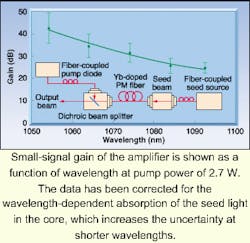Although polarization-maintaining (PM) passive fiber is widely available, it can be difficult to find the PM rare-earth-doped double-clad fiber often demanded by higher-power (greater than 100 mW) fiber laser and amplifier applications. Now, however, scientists at Sandia National Laboratories (Livermore, CA), working with colleagues at the Naval Research Laboratory (Washington, D.C.) and Redfern Fibres (Eveleigh, Australia), have developed a PM double-clad ytterbium-doped fiber amplifier based on bow-tie fiber.
The research team reports that, with borosilicate stress elements incorporated in the inner cladding of the fiber, the system yields a beat length of 5.1 mm at 633 nm.
In addition, by pumping the fiber at 975 nm and seeding it with linearly polarized light, they can produce a polarization extinction ratio greater than 15 dB, independent of pump power.
The modified chemical-vapor deposition process used to fabricate the fiber introduced the ytterbium into the core prior to collapse of the preform. As a result, the stress regions consisting of the borosilicate glass have a nearly ideal bow-tie shape, with an inner diameter approximately twice that of the core diameter. In addition, their outer diameter is 63% of the cladding diameter, which reportedly provides about 95% of the calculated birefringence.
The fiber was drawn with an inner cladding diameter of 150 m and coated with a low-index polymer. Its core numerical aperture was also set as low as possible without introducing excess bend sensitivity. This allowed the researchers to optimize the fiber for both high peak-power and high average-power applications.
The scientists then built a high-power PM amplifier with 9.5 m of the bow-tie fiber (see figure). Interestingly enough, during their experiments, they found that coiling the fiber did not decrease the slope efficiency or increase the threshold pump power of the device, which means that future fiber could be drawn to have a smaller single-mode core.
At a pump power of 5.7 W, the device produced a saturated output power of 2.3 W. Decreasing the seed power by 20% reduced output power by less than 4% for pump power exceeding 5.2%. When the researchers moved to higher pump power and an 8-m-long amplifier, they obtained up to 3.5 W of output power with no degradation in the polarization extinction ratio. No stimulated Brillouin scattering was observed, something the scientists credit to the large core diameter and low numerical aperture of the fiber.
It is important to note that the process used to develop this high-power PM amplifier is also compatible with other rare-earth dopants, core and cladding sizes, and core numerical apertures. This should increase the potential applications that could benefit from the fabrication technique.
About the Author
Paula Noaker Powell
Senior Editor, Laser Focus World
Paula Noaker Powell was a senior editor for Laser Focus World.
